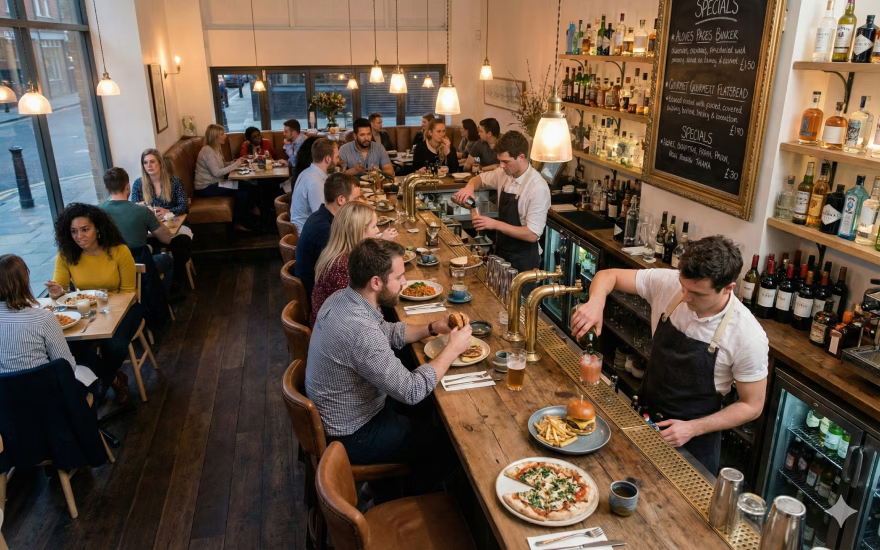AI is Cooking Up Big Changes in the Fast Food Sector

More fast food chains are going all-in on artificial intelligence. And it’s not just to jump on the bandwagon and impress us with cool tech. They’re leveraging AI to make their operations faster, smarter, and more efficient. From robot-powered kitchens to AI-driven hiring tools, major brands are using AI technology to serve up speed and accuracy like never before. Here’s how your favorite fast food joints are using AI to transform the way we eat on the go.
How Are Fast Food Restaurants Using AI?
1. Drive-Throughs That Actually Get Your Order Right
Ordering at the drive-through can sometimes feel like a game of chance. Will your order be correct so you can speed through the lane with your food, or will you be stuck in a loop of clarifying and repeating your order? Thankfully, AI is changing that. Chains like Wendy’s and Taco Bell have already rolled out AI-powered drive-through assistants that take your order with near-perfect accuracy, even recognizing different accents and slang.
In 2023, Wendy’s partnered with Google Cloud to create FreshAI, a voice assistant that processes orders faster and recommends menu items based on customer preferences. In 2025, the company plans to expand the voice-activated AI drive-through system from the current 100+ locations to around 500 to 600 locations by the end of the year.
Yum! Brands is also aiming for the global rollout of its voice AI technology and has been investing heavily in AI-driven tech. Currently, more than 100 Taco Bell locations across 13 states are already using AI-powered drive-throughs. Other fast food chains, including McDonald’s, Burger King, and Dunkin’, are also exploring this technology. As these AI-driven ordering systems speed things up and reduce human error, we’ll no longer have to worry about our request for "extra pickles" turning into "extra napkins!"

2. From Robots to Drones: AI Delivery Service Takes Flight
Commonly deployed as robot servers or delivery bots, AI-powered food delivery is changing how restaurants are serving their customers. These machines are powered by advanced tech like robotics, machine learning, and automation, which enable them to move toward a preset destination. With their ability to optimize routes and delivery times, they can quickly get food from the kitchen to the customer’s table or even their home. These AI-powered autonomous deliveries can also help reduce labor costs while keeping operations running smoothly — even during staffing shortages.
Autonomous robots have already been bringing orders straight to customers inside restaurants or within nearby areas. Domino’s, one of the first fast food chains to introduce robot delivery vehicles, continues to explore the technology to speed up service despite staffing shortages.
Now, the technology is going even further, literally. AI-driven drones are taking fast food delivery to the skies. Subway showed it could make drone delivery possible during its Footlong Sub campaign on World UFO Day. Delivery drones swept the sky of Atlanta, Dallas, Denver, and Orlando to drop Subway's Ultimate Footlong Offering to the yards of the most active Subway MVP Rewards members. While it was a one-day promotional event, it's an exciting glimpse into the future.
If you’re among those looking forward to having drone delivery as a regular delivery option, you may not have to wait that long to enjoy the service. The recent partnership between DoorDash and Wing brings together on-demand food delivery and autonomous drones to provide fast and contactless deliveries in more locations. With DoorDash’s robust platform and Wing’s drone tech, we’re likely to see more drone deliveries sweeping the skies above. Although the service is still limited to deliveries for Wendy’s, their first restaurant partner, in Virginia, many are still excited to eventually have a squadron of drones delivering food in their neighborhoods.
If you’re a restaurant owner struggling to find delivery drivers, maybe it’s time to consider getting a robot that can roll right up doorsteps with a hot pizza or literally drop subs from the sky.
3. Smarter Systems = Faster, Fresher Food
Chains are using AI and predictive analytics to target ads based on everything from your past orders to the weather (yep, AI knows you’re more likely to crave an iced coffee on a hot day). McDonald’s even uses AI to adjust its digital menu boards in real time, suggesting different items based on trends, location, and time of day. These digital menu boards work so well in helping customers with their orders that they’ve resulted in a 20% increase in sales.
But AI isn’t just taking orders; it’s doing its magic in the kitchen too! Yes, we’ve seen clips of robots making hilarious mistakes while prepping food orders, but CaliExpress by Flippy is proving to skeptics that an autonomous kitchen won’t be a big flop. This pop-up eatery with an open kitchen shows robots in action making burgers, deep frying chicken and fries, and serving food. With CaliExpress offering a real preview of how robots can make kitchens more efficient, the idea of an all-robotics restaurant is fast gaining traction among fast-food operators.

4. AI Aids in Staffing to Keep Hiring and Scheduling Burnout at Bay
Finding and keeping workers in the fast food industry is not as simple as dumping fries in the deep fryer. This is why AI-powered recruitment and scheduling tools are a lifesaver — or should we say, a business-saver — for fast food owners. They help ensure that stores are always staffed properly and that shifts are scheduled optimally to avoid overworking employees. Happier employees mean better service for customers, so everyone wins!
One concrete example of this is Chipotle’s Ava Cado. In the last quarter of 2024, Chipotle rolled out its new AI-powered hiring system from Paradox. Now, candidates are screened and processed by Ava Cado, an AI hiring assistant. By automating tasks like collecting information, scheduling interviews, and sending job offers, Chipotle can fill positions faster than you can say guacamole.
5. Streamlined Fast Food Operations Result in Faster Business Growth
AI isn’t just shaking up the kitchen or making ordering a breeze. It’s also stepping in to streamline the behind-the-scenes operations that keep fast food businesses running smoothly. From managing inventory to processing payroll, AI is helping drive growth and efficiency across the board.
A couple of years ago, Domino’s Pizza piloted its AI solutions for inventory, supply chain, and logistics management. Partnering with Microsoft, they now use Azure and OpenAI to personalize customer experiences, predict demand, optimize inventory, and streamline logistics.

The Future of Fast Food: AI Is Just Getting Started
Faster service, smarter staffing, and better customer experiences are just the beginning of what AI can do in the fast food sector. In the near future, we could see even more advanced AI-powered kitchens, fully automated restaurants, and even personalized meal recommendations based on health data.
One thing is certain: fast food is getting smarter. And it’s no longer a secret that AI is the secret sauce making it all happen. So the next time you grab a burger, just know that behind the scenes, AI might be the one taking your order, cooking your fries, and even predicting what you’ll want to eat next!
And if you’re in the restaurant business, now is the time to explore AI-driven solutions like Push Operations. Implementing innovative technologies will allow you to serve customers faster, optimize labor costs, and stay ahead in an increasingly competitive industry.



